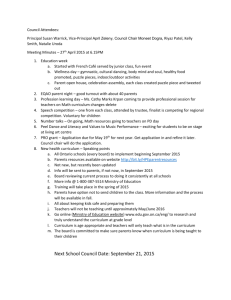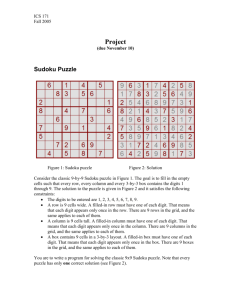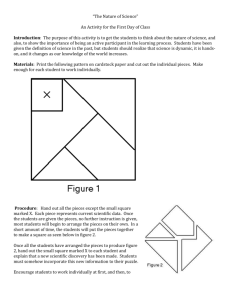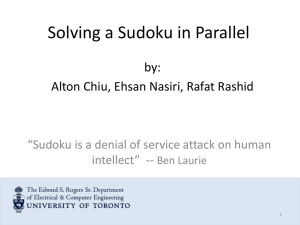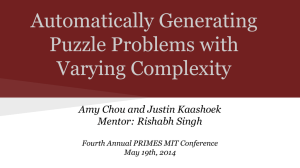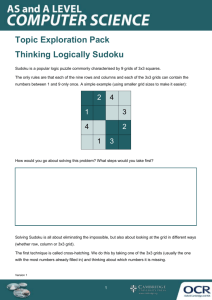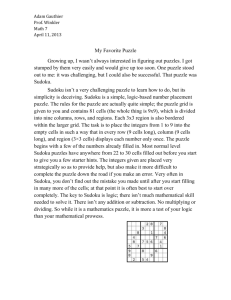COSC 2P03 Assignment 2
advertisement
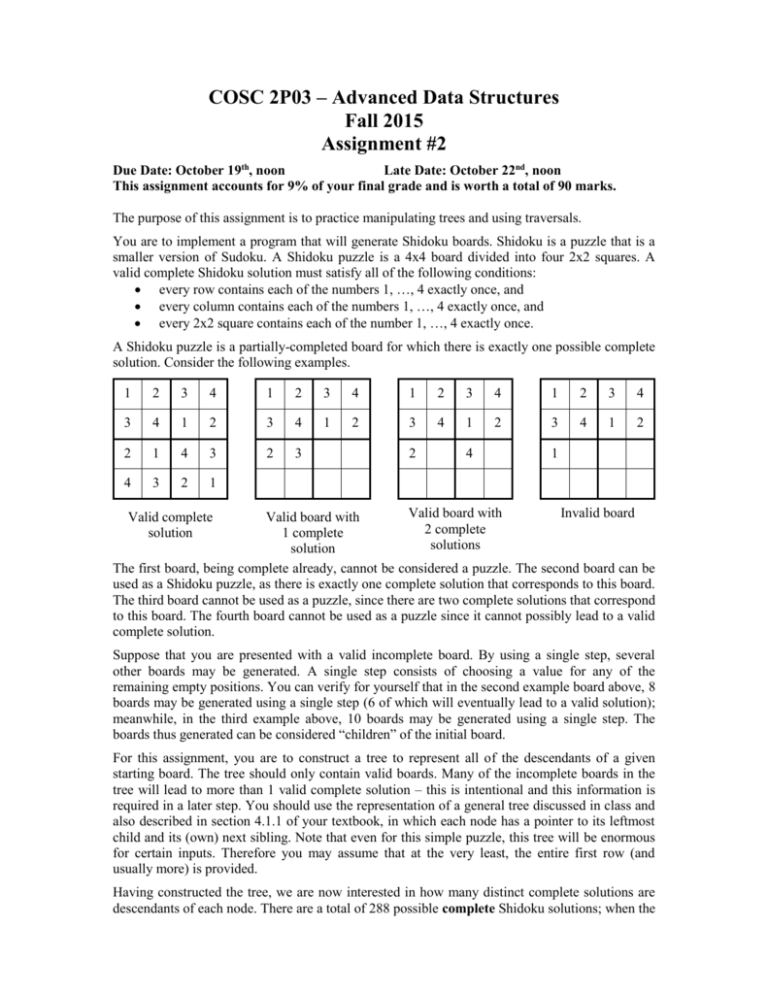
COSC 2P03 – Advanced Data Structures Fall 2015 Assignment #2 Due Date: October 19th, noon Late Date: October 22nd, noon This assignment accounts for 9% of your final grade and is worth a total of 90 marks. The purpose of this assignment is to practice manipulating trees and using traversals. You are to implement a program that will generate Shidoku boards. Shidoku is a puzzle that is a smaller version of Sudoku. A Shidoku puzzle is a 4x4 board divided into four 2x2 squares. A valid complete Shidoku solution must satisfy all of the following conditions: every row contains each of the numbers 1, …, 4 exactly once, and every column contains each of the numbers 1, …, 4 exactly once, and every 2x2 square contains each of the number 1, …, 4 exactly once. A Shidoku puzzle is a partially-completed board for which there is exactly one possible complete solution. Consider the following examples. 1 2 3 4 1 2 3 4 1 2 3 4 1 2 3 4 3 4 1 2 3 4 1 2 3 4 1 2 3 4 1 2 2 1 4 3 2 3 4 3 2 1 2 4 1 Valid board with Invalid board Valid board with 2 complete 1 complete solutions solution The first board, being complete already, cannot be considered a puzzle. The second board can be used as a Shidoku puzzle, as there is exactly one complete solution that corresponds to this board. The third board cannot be used as a puzzle, since there are two complete solutions that correspond to this board. The fourth board cannot be used as a puzzle since it cannot possibly lead to a valid complete solution. Valid complete solution Suppose that you are presented with a valid incomplete board. By using a single step, several other boards may be generated. A single step consists of choosing a value for any of the remaining empty positions. You can verify for yourself that in the second example board above, 8 boards may be generated using a single step (6 of which will eventually lead to a valid solution); meanwhile, in the third example above, 10 boards may be generated using a single step. The boards thus generated can be considered “children” of the initial board. For this assignment, you are to construct a tree to represent all of the descendants of a given starting board. The tree should only contain valid boards. Many of the incomplete boards in the tree will lead to more than 1 valid complete solution – this is intentional and this information is required in a later step. You should use the representation of a general tree discussed in class and also described in section 4.1.1 of your textbook, in which each node has a pointer to its leftmost child and its (own) next sibling. Note that even for this simple puzzle, this tree will be enormous for certain inputs. Therefore you may assume that at the very least, the entire first row (and usually more) is provided. Having constructed the tree, we are now interested in how many distinct complete solutions are descendants of each node. There are a total of 288 possible complete Shidoku solutions; when the first row is provided, only 288/(4!) = 12 are possible (see [1] and [2]). However, generally each complete Shidoku solution will appear as a leaf several times, since it may be obtained by different sequences of choices. Consider the following example: 1 2 3 4 1 2 3 4 1 2 3 4 3 4 1 2 3 4 1 2 3 4 1 2 2 1 4 3 2 1 4 3 2 1 Valid Complete Solution 2 3 Valid board leading to complete solution Valid board leading to complete solution The first board above is a descendant of both the second board and the third board (and others). To find the number of distinct complete solutions descended from each board, use a recursive postorder traversal and store the count (together with the corresponding distinct complete solutions themselves) in the node corresponding to that board. Finally, use a recursive preorder traversal to examine each node in the tree for the following condition: if there is only one distinct complete solution for a given board, and its parent has more than one distinct complete solution, then print out the board. After the traversals are complete, print a count of the total number of nodes that correspond to a single complete solution (this total number may be obtained during one of the traversals). This is, of course, the total number of distinct puzzles that arise from the initial board configuration. There are many thousands of possible Shidoku puzzles (see [2]). Since we are restricting ourselves to a given starting configuration, we should obtain a much smaller number. For submission purposes, you must hand in the output obtained by running your program using the input file assn2in.txt found on the course website. This file gives the known entries (1,2,3 or 4) of the board in row-major order, with 0 for unknown entries. Your program will be tested using other input files; therefore you must make sure that your program is thoroughly tested. Warning: do not attempt to run your program starting from an initially empty board, as this will take a huge amount of both time and memory. Submission Requirements: All of the following must be submitted in an envelope in the COSC 2P03 assignment box: 1. A cover sheet, available from http://www.cosc.brocku.ca/forms/cover, completely filled out. Your assignment will not be marked unless one is submitted with the assignment. 2. A commented and properly documented source code listing for your program. 3. A listing of the output for your program from the supplied input, assn2in.txt. 4. A statement specifying whether you used NetBeans or DrJava (to make it easy for the marker to run it). You must also submit your assignment electronically so that it can be checked for plagiarism using MOSS. To do this, create a directory on Sandcastle containing all files for this assignment, and run the script submit2p03 from this directory. Your assignment will not be marked unless this is done. References: 1. Dianne Henry, “Sudoku for Dummies: A Mathematicians Approach, manuscript available online from math.missouristate.edu/assets/Math/Sudoku.doc 2. Sourendu Gupta, “Shi Doku: Exploring the Mathematics of Su Doku”, website available at http://theory.tifr.res.in/~sgupta/sudoku/shidoku.html

